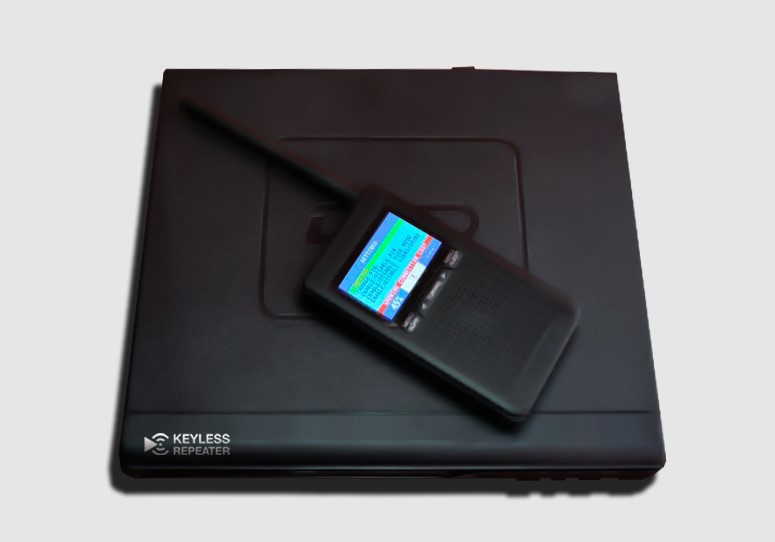In the modern automotive landscape, keyless entry systems have become a standard feature, offering convenience and a touch of luxury to drivers and passengers alike. These systems allow car owners to unlock and start their vehicles without ever touching a key, relying instead on wireless signals between the car and a remote fob. While this technology enhances user experience due to its simplicity and ease of use, it also opens the door to new forms of automotive theft.
Enter the keyless repeater box—a device that exploits the very convenience that makes keyless entry systems so appealing. At its core, a keyless repeater box is a sophisticated piece of technology designed to intercept and relay signals from a car key fob to the vehicle, tricking the car into thinking the key fob is closer than it actually is. This allows thieves to unlock and start a vehicle without needing the physical key fob. Originally developed for legitimate uses like recovery operations by locksmiths or law enforcement, these devices have unfortunately found a prominent place in the arsenal of modern car thieves.
Table of Contents
ToggleWhat is a Keyless Repeater Box?
A keyless repeater box is an electronic device that captures, amplifies, and transmits signals between a car and its keyless entry remote, also known as a key fob. Despite its relatively simple appearance, the device is powered by complex radio technology that enables it to bridge considerable distances between the key fob and the vehicle. This capability can manipulate the convenience feature of keyless entry systems, turning it into a vulnerability.
Technical Explanation of a Keyless Repeater Box
The keyless repeater box consists of two main components: a transmitter and a receiver. The receiver is typically placed near the key fob, where it can pick up the low-strength signal that the fob emits. This signal, although not designed to travel far, contains all the necessary information to unlock and start a car. Once the receiver captures this signal, it is sent to the transmitter unit, which is located near the vehicle. The transmitter then broadcasts the signal as if it were coming from the key fob itself. Modern vehicles that rely on proximity sensors will recognize this signal, interpreting it as the key fob being within the required range to allow entry and ignition.
How Keyless Repeater Boxes Work with Car Keyless Entry Systems
Keyless entry systems in cars operate using a challenge-response authentication method over radio frequencies, typically in the range of 315 MHz in the United States and 433.92 MHz in Europe. When a person carrying the key fob approaches the car, the car sends out a signal requesting a response from the key fob. Under normal circumstances, this interaction is limited to a few feet to ensure security.
However, with a keyless repeater box, this secure distance can be bypassed. The device effectively extends the reach of the key fob’s response, making the car think that the key fob is within the normal range even when it is far away, possibly even inside the owner’s house. This technology not only poses a significant security threat but also highlights a critical flaw in the convenience features of modern automotive design, making it imperative for car owners to understand and mitigate these risks.
The Technology Behind Keyless Repeaters
Keyless repeater boxes harness advanced radio frequency (RF) technology to manipulate the communication between a car’s keyless entry system and its corresponding key fob. Understanding this technology is crucial for recognizing both the sophistication of modern automotive theft and the potential countermeasures.
Detailed Description of the Technology Used in Keyless Repeater Boxes
The primary technology behind a keyless repeater box involves RF communication and signal amplification. These devices are equipped with two main components—each a sophisticated combination of a receiver and a transmitter. The first component acts as a remote sensor, placed near the key fob to detect and capture the specific frequency on which the fob communicates. This component must have a sensitive receiver to pick up the weak signals that the fob emits, even from inside a building or from a considerable distance.
Once the signal is captured, it is transmitted—often via a stronger RF signal—to the second component of the repeater system positioned near the vehicle. This part of the device then acts as a pseudo-key fob, broadcasting the originally weak signal with enough strength to reach the car’s sensors, fooling them into thinking that the actual key fob is in close proximity.
Frequency and Signal Relay Process Explained
Key fobs and vehicle sensors communicate using specific radio frequencies assigned for automotive use. In the United States, the most common frequency for keyless entry systems is 315 MHz, whereas in Europe, it is typically 433.92 MHz. These frequencies allow for the secure transmission of data over short distances, a feature designed to enhance security by limiting the range over which the fob can operate.
The signal relay process in a keyless repeater box involves several steps:
- Signal Detection: The receiver unit detects the signal from the key fob, which contains a unique, encrypted code that the car’s system recognizes. This signal is typically weak, designed only to travel a few feet.
- Signal Capture and Amplification: Once detected, the signal is amplified to preserve its integrity over a longer distance than originally intended.
- Signal Transmission: The amplified signal is then sent to the transmitter unit near the vehicle. This part of the process may use a higher power setting or even a different frequency to ensure that the transmission covers the distance without degradation.
- Signal Broadcasting: The transmitter unit near the car broadcasts the amplified signal to the vehicle’s keyless entry sensor, mimicking the presence of the key fob.
Legal and Ethical Considerations
Keyless repeater boxes sit in a gray area both legally and ethically, presenting challenges that vary significantly across different jurisdictions. Understanding the legal framework and ethical implications of using these devices is essential for consumers, law enforcement, and the automotive industry.
Overview of the Legal Status of Keyless Repeater Boxes in the U.S.
In the United States, the legality of owning and using keyless repeater boxes is complex. Federal law, specifically under the Federal Communications Commission (FCC), regulates devices that transmit radio frequencies, which includes keyless repeaters. While the sale and possession of such equipment aren’t outright illegal, their use in committing crimes such as theft is prosecuted under various state and federal laws. For example, using a keyless repeater box to gain unauthorized access to a vehicle without the owner’s permission constitutes theft or burglary, depending on the state’s statutes.
Several states have taken specific actions against the unauthorized use of electronic devices for intercepting or disrupting the electronic communication between a key fob and a vehicle. These legislative measures aim to close loopholes that might allow criminals to exploit emerging technologies for illicit purposes.
Ethical Implications of Using a Keyless Repeater Box
Ethically, the use of keyless repeater boxes raises significant concerns, particularly regarding privacy and property rights. The primary ethical issue with these devices lies in their potential to undermine the security measures that vehicle owners rely on to protect their property. The unauthorized use of such technology to access someone else’s vehicle without consent not only breaches personal privacy but also erodes trust in the security of modern keyless entry systems.
Moreover, there are ethical concerns related to the sale and distribution of these devices. Retailers and manufacturers may argue that keyless repeaters have legitimate uses, such as by locksmiths or in recovery operations by law enforcement and rescue services. However, the potential for misuse by thieves is significant and poses ethical questions about the responsibility of sellers to prevent their products from being used harmfully.
Security Risks Associated with Keyless Repeater Boxes
Keyless repeater boxes pose significant security risks, evidenced by their increasing use in vehicle thefts. These devices, which exploit vulnerabilities in keyless entry systems, have led to a rise in sophisticated vehicle theft across the globe. This section explores specific case studies and statistics that highlight the security challenges associated with electronic device interference in modern vehicles.
Case Studies of Thefts Involving Keyless Repeater Boxes
1. Luxury Vehicle Thefts in California: In a notable instance, thieves in California used keyless repeater boxes to steal high-end vehicles parked in residential driveways. These thefts typically occurred at night, with the thieves quietly unlocking and starting vehicles without breaking windows or causing any immediate physical damage, leaving victims unaware until the following morning.
2. Theft Rings in Europe: European police have uncovered organized crime rings using keyless repeaters to target luxury cars. In one case, a ring stole over 50 vehicles by using these devices to extend the range of key fobs inside owners’ homes, enabling them to drive away with the cars without any forced entry.
3. Rental Car Thefts: There have also been reports of rental cars being stolen through the use of keyless repeaters. Thieves rent a car, clone the key fob during the rental period, and later use a repeater box to steal the vehicle from the rental lot.
Statistics on Car Theft Rates Linked to Electronic Device Interference
- Increase in Theft Rates: According to various law enforcement agencies, there has been a noticeable increase in the theft rates of vehicles equipped with keyless entry systems. In some areas, vehicles with keyless entry systems are now five times more likely to be stolen than those without.
- Recovery Rates: The recovery rate of vehicles stolen using electronic interference is significantly lower than that of vehicles stolen through traditional means. This suggests that thieves using technology like keyless repeaters are often more organized and plan their thefts to avoid later recovery by authorities.
- Insurance Claims: Insurance companies have reported a rise in claims for stolen vehicles that involve no signs of forced entry. This trend correlates with the increased use of devices like keyless repeaters, which allow thieves to access and steal cars cleanly and quietly.
How Car Owners Can Protect Themselves
As keyless repeater boxes become a more common tool for car thieves, it’s crucial for car owners to adopt strategies and devices that can mitigate the risks associated with these attacks. This section offers practical tips and recommendations for enhancing vehicle security against keyless entry hacking.
Tips for Safeguarding Vehicles Against Keyless Repeater Box Attacks
1. Use a Faraday Pouch: Store your key fob in a Faraday pouch when not in use. These pouches are designed to block RF signals, preventing keyless repeater boxes from picking up and relaying signals from your key fob.
2. Turn Off Key Fob Wireless Signals: Some modern key fobs come with the option to turn off their wireless signal. Consult your vehicle’s manual to see if this feature is available and use it, especially when the fob is not in use for extended periods.
3. Park Securely: Whenever possible, park your vehicle in a secure, locked garage. If a garage is not available, try to park in well-lit, populated areas to deter theft.
4. Reevaluate Parking Habits at Home: Park as close to your home as possible, ideally within the range of a security camera or under a light. The proximity to your home and the presence of security measures can deter thieves.
Recommended Security Devices and Practices
1. Aftermarket Immobilizers: Consider installing an aftermarket immobilizer system that requires more than just the key fob’s presence to start the car, such as a PIN code or additional physical key.
2. Mechanical Steering Wheel Locks: Use a mechanical steering wheel lock. These devices are not only a physical barrier to theft but also serve as a visible deterrent that can discourage thieves from even attempting to steal the vehicle.
3. Install Security Cameras: Set up security cameras that cover where you park your vehicle. Cameras can deter thieves and help in the recovery of the vehicle if stolen.
4. GPS Tracking Devices: Equip your car with a GPS tracking device. In the event that your vehicle is stolen, a GPS tracker increases the chances of recovering it quickly.
5. Regularly Update Vehicle Software: Ensure that your vehicle’s software is up-to-date. Automakers often release software updates to patch security vulnerabilities, including those that may affect keyless entry systems.
Latest Advances in Anti-Theft Technology
As vehicle theft techniques become more sophisticated, particularly with the use of devices like keyless repeater boxes, the automotive industry continues to innovate and develop more secure anti-theft technologies. This section highlights the latest advances designed to counteract keyless repeater vulnerabilities and explores future trends in vehicle security technology.
Innovations in Car Security that Counteract Keyless Repeater Box Vulnerabilities
1. Encrypted Key Fob Signals: Many automakers are now incorporating advanced encryption into the communication between key fobs and vehicles. This encryption makes it much harder for thieves to intercept and mimic the key fob’s signal, as they would need to break complex encryption to do so.
2. Biometric Verification: Some newer models are integrating biometric systems, such as fingerprint and facial recognition technologies, that must confirm the identity of the user along with the presence of the key fob before allowing access or engine start-up. This adds a layer of security that cannot be easily replicated by electronic means.
3. Proximity Detection Enhancements: Enhancements in proximity sensors are being developed to more accurately detect the actual distance of a key fob. This technology aims to diminish the effectiveness of repeater boxes, which rely on fooling the vehicle’s system about the proximity of the key fob.
4. Onboard Diagnostics (OBD) Locks: To prevent unauthorized access through the vehicle’s diagnostic port, OBD locks are being used more commonly. These locks can prevent hacking via the diagnostic port, which is another method used to bypass vehicle security systems.
Future Trends in Vehicle Security Technology
1. Integration of Vehicle-to-Everything (V2X) Communications: As the Internet of Things (IoT) continues to evolve, vehicles are becoming part of a larger connected ecosystem. V2X communication can allow vehicles to authenticate each other and their environment, potentially reducing the risk of theft through community-based monitoring and alert systems.
2. Advanced Real-Time Monitoring: Future security systems may include more advanced real-time monitoring capabilities, using AI to detect unusual behavior or unauthorized access attempts. This could involve continuous learning systems that adapt to new theft methods, including the detection of signal relay attacks.
3. Use of Blockchain Technology: Blockchain could be used to create a secure, unalterable record of a vehicle’s access and usage history. This could prevent unauthorized access by ensuring that vehicle entry and start-up are contingent on verification entries in the blockchain.
4. Energy Harvesting Power Sources: As a preventive measure against electronic tampering, future security devices might employ energy harvesting methods to remain powered and vigilant indefinitely, without requiring battery changes or charging.
FAQs
1. What is a keyless repeater box?
- A keyless repeater box is a device that captures and relays signals from a vehicle’s key fob to the car, tricking the car into thinking the key fob is closer than it actually is. This allows unauthorized users to unlock and possibly start the vehicle without physical access to the key fob.
2. Are keyless repeater boxes illegal?
- The legality of keyless repeater boxes varies by jurisdiction. In many places, owning such a device is not illegal, but using it to commit a crime, such as vehicle theft, is illegal.
3. How can I protect my car from keyless repeater box attacks?
- To protect your car, consider using a Faraday pouch to store your key fob, turning off the key fob when not in use, using additional security devices like steering wheel locks or aftermarket immobilizers, and parking in secure, well-lit areas.
4. How do I know if my vehicle is vulnerable to a keyless repeater box?
- If your vehicle uses a keyless entry system, it may be vulnerable to keyless repeater boxes. Consult your vehicle’s manufacturer or refer to your owner’s manual for information about your specific vehicle’s security features.
5. Can keyless repeater boxes be detected?
- Detecting a keyless repeater box in use can be challenging because these devices are designed to be discreet and do not interfere directly with the vehicle’s electronics in a detectable way. Regular security checks and using signal-blocking measures can help mitigate the risk.
Additional Resources for Vehicle Security
- National Highway Traffic Safety Administration (NHTSA): Offers guidelines and tips for vehicle theft prevention. NHTSA Vehicle Safety
- Insurance Institute for Highway Safety (IIHS): Provides research and data on vehicle theft and security devices. IIHS Topics
- Federal Communications Commission (FCC): Information about the legal use of radio frequency devices, including those used in vehicle security systems. FCC General Information
- Automobile Association Websites: Many automobile associations offer detailed guides and tips for enhancing vehicle security.
- Local Law Enforcement Agencies: Often provide community-specific information and resources on preventing vehicle theft.







